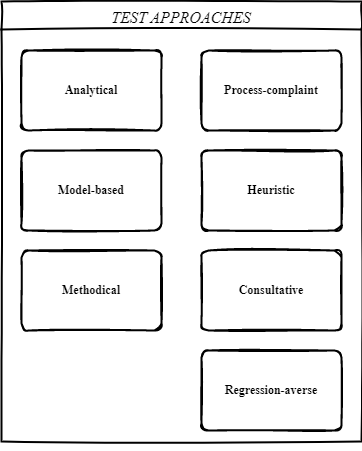
Apply Test Automation To Test Approach
When you think about test automation, the first thing that comes to your mind is automating already written manual test cases. Well, test automation is more than that. First of all, is not an objective, instead, it’s a test strategy that can result in higher test efficiency and earlier bug detection.
Test automation can be achieved differently with a different tech stack and platforms depending on the team’s requirements. Usually, in one organization especially a large-scale one, one test automation solution is not the best idea, therefore, multiple strategies are implemented and applied in the testing activities. The automation strategy can affect activities like test environment configuration, data management, report, and test comparisons.
Also, when you apply test automation, you are indirectly affecting the sprint goals. Either start apply test automation within the agile team or have a separate test automation independent team creating, performing, and maintaining a set of automated regression tests for multiple teams per sprint.
Test Approaches

Analytical
One of the basic and most important approaches out there, the analytical approach allows automated tests to be created in parallel with eh development of the functionality. A primary example is BDD and ATDD techniques where the focus is on system behavior and capturing requirements respectively.
Model-based
This approach allows the creation of automated tests during user story implementation by creating a separate model per requirement. The models are used for testing the functional and non-functional behavior of the system.
Methodical
A form of a checklist containing all the logical conditions that may affect or relate to a specific domain, application, or type of test, and therefore, it can be used for effective test execution.
Process-complaint
This approach is useful when a project needs to conform to predefined standards and regulations since this can affect how to apply test automation properly. It will also influence the flow of automated tests, and how they are captured and created.
Heuristic
A heuristic or reactive approach is especially beneficial in Agile-oriented projects and teams while automated test cases are playing a verification role. Exploratory or error-guessing types of tests can increase the test coverage for automated tests which can lead to a greater level of manual test coverage.
Consultative
In some cases, the test coverage can be defined by the stakeholder. If this is the case then the team must respond to change quickly by adapting all the test cases and then eventually automating them. This is done using the directive or consultative approach where the test effort in time and skill is really important.
Regression-averse
Many projects have a large set of regression tests that keep growing and growing. For an enterprise company writing new test cases and then maintaining them can cause a headache. Instead of focusing on writing a new set of tests, this approach focuses on refactoring the already existing ones so that it can cover a vast portion of the application with the exception of new functionalities that require a new set of tests.
Level of Automation
Organizations not only apply test automation to various approaches, but they also apply it to their overall deployment process. That is why continuous deployment exists. It is an automated process where the automated tests must be sufficient and have a respective level of code quality. Unit, integration, and system automated tests must be executed on a daily basis as part of the CD, but also, manual tests still need to be performed in some cases.
If you want to learn more about how you can contribute to automation and how to constantly be involved in the testing activities during SDLC feel free to Enroll Now for Continuous Testing in DevOps By Edureka!
Even though test automation plays a huge role in Agile projects, there are some challenges:
- The capacity of the test suite
- Each sprint introduces new functionality and therefore a new set of tests to be written. This means that the overall number of tests is increasing per sprint. Even though we need new tests for new functionality, the main goal here is to try to refactor existing ones to increase the coverage without significantly increasing the test size. But either way, the effort and time needed to refactor, the existing tests or write new ones will increase over time.
- Test creation time
- Creating new tests that verify new features isn’t an easy job. This doesn’t only require one to have automation knowledge but also test data to pass as a set of input and prepare the test environment as well.
- Test execution time
- As the test suite size increases over time, the execution time increases as well. That’s why you need to keep track of your current number of test cases.
- Resource availability
- The engineers who will automate the test cases need to be available. This means you need to make sure that at least one engineer who has the necessary knowledge is available to pick the task and start automating.
One approach to mitigate these challenges is to pick those tests that are of higher risk and they will be part of a daily execution to verify the parts of the application that are most important. Another is to automate as many tests as possible to increase the frequency of deployment in separate executions but keep in mind the overall test execution time.
Aside from the challenges many are facing while introducing test automation in the projects, let’s take a look at some of the benefits when you apply test automation:
- When you apply test automation as part of your CD, you are guaranteed that you will have a repeatable test execution per build
- Decreases test execution and increase the test deployment time
- Faster time to market and customer feedback











